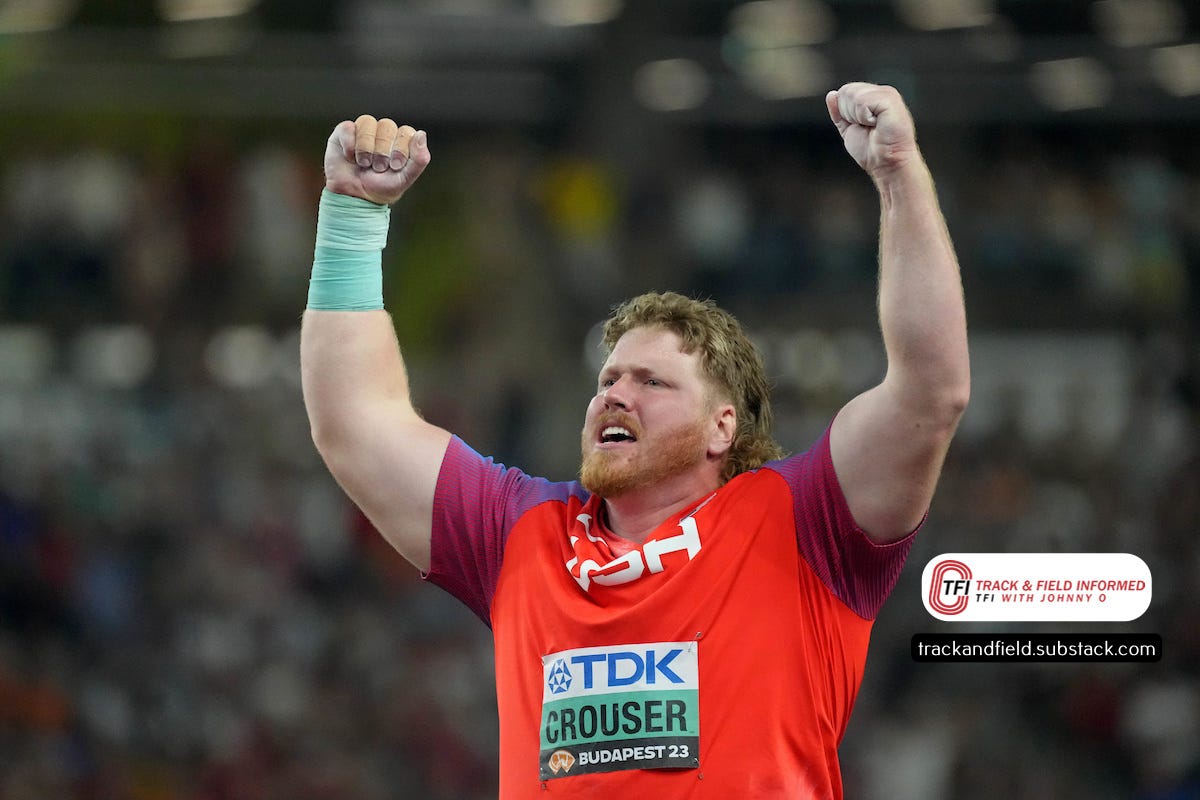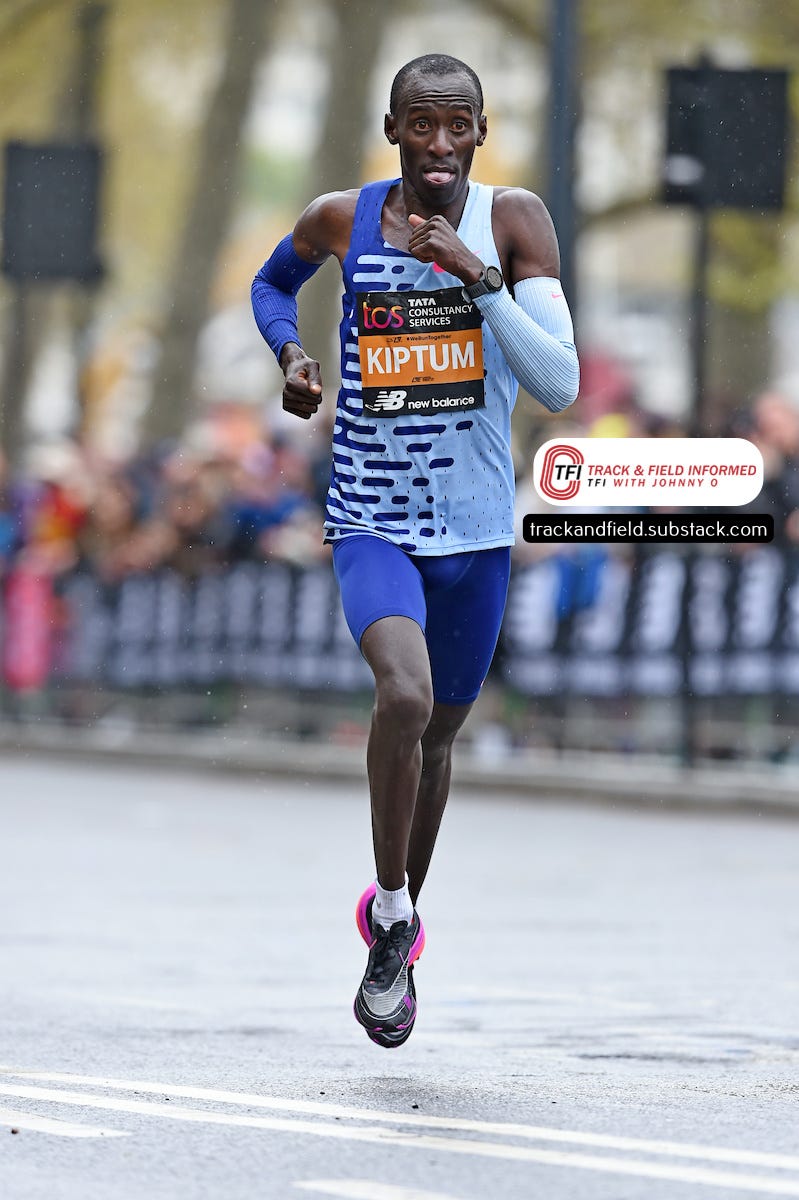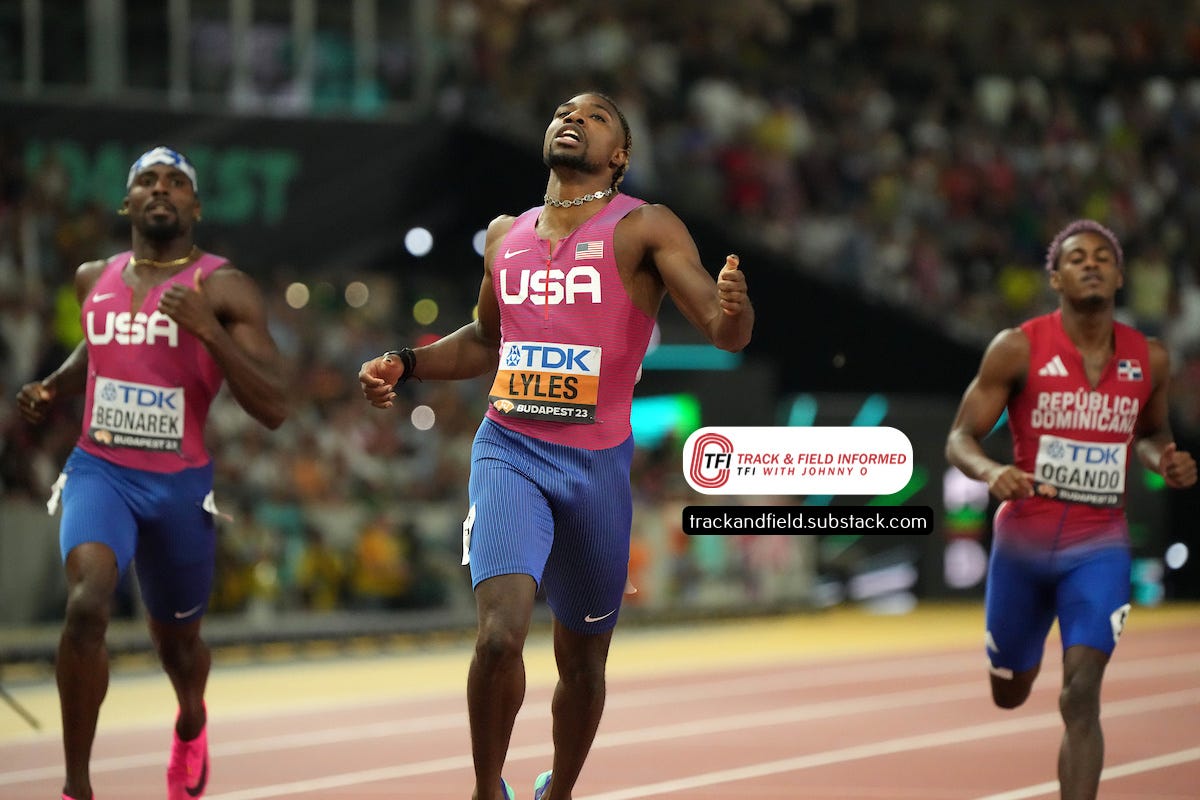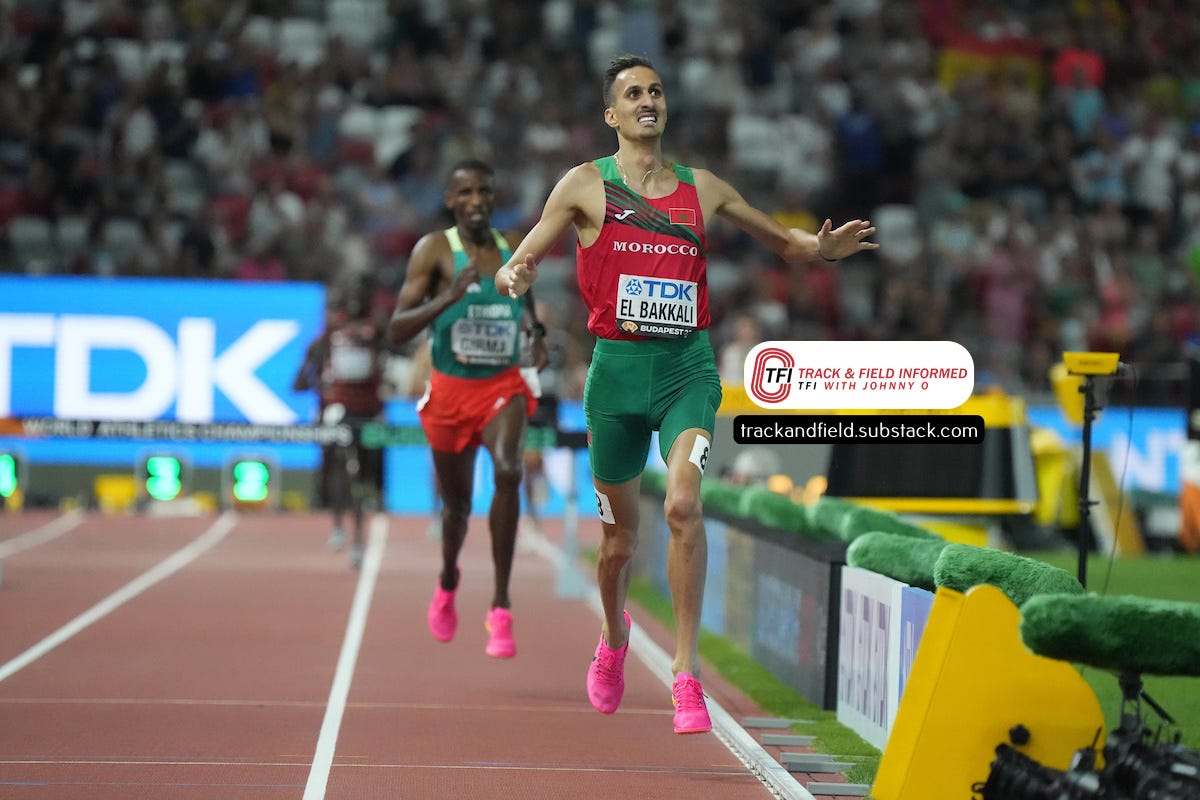Dramatic victory in World Champs puts Crouser over the top
American's win, while competing with blood clots in leg, was a key factor in his selection as men's athlete of the year

Ryan Crouser of the United States.
Mondo Duplantis of Sweden.
Kelvin Kiptum of Kenya.
When it came time to choose a men’s track and field athlete of the year for 2023, those were the three athletes (in alphabetical order) who I felt were most deserving of the honor.
Crouser and Kiptum each set a world record in the shot put and marathon, respectively, during the year. Duplantis set a pair of them in the pole vault.
Kiptum won the London and Chicago marathons with the Nos. 3 and 1 performances in history and his time of 2 hours 35 seconds in the Windy City in October made him the first man to run under 2:01 in a certified race.
Duplantis cleared the two highest bars ever in the pole vault, at 6.23 meters (20 feet 5¼ inches) and 6.22 (20-4¾), and was victorious in 16 of 17 meets. In addition, he jumped 6.10 (20-0¼) or higher in seven meets, a height no one else achieved even once.
Crouser produced the two best efforts in the history of the shot put, with marks of 23.56 (77-3¾) and 23.51 (77-1¾), and won 12 of 13 competitions. He also had the top seven puts in the world during the year and 11 of the top 12.
However, the No. 1 factor that ultimately led me to select him as the men’s AOY was his gold-medal performance in the World Athletics Championships in Budapest, Hungary, in August.
Crouser, who turned 31 last month, was heavily favored to win his second consecutive World title two days before the championships started on Aug. 19. But he announced on social media the day before the meet began that he had been diagnosed with a pair of blood clots in one of his calf muscles and had been unable to train consistently for the previous three weeks while experiencing persistent pain in the area.
Although he had been given medical clearance to fly to Budapest and compete, he sounded unsure about how he would fare in an interview with NBC Sports the night before the championships began, basically stating that he was just glad to have a chance to participate.
But after advancing to the final with a single put of 21.48 (70-5¾) in the qualifying round on the morning of the first day of the meet, Crouser’s competitive juices kicked in during the finals that night.
He took the lead in the first round with an effort of 22.63 (74-3), although he appeared to be holding back. He was more aggressive in the second round and the result was a 22.98 (75-4¾) effort that broke the meet record of 22.94 (75-3¼) that he had set in winning his first World title in the 2022 championships in Eugene, Oregon.
A put of 22.28 (73-1¾) in the third round was followed by a pair of fouls in the fourth and fifth rounds. But knowing that the gold medal was his as he stepped into the ring for the final put of the competition, he threw caution to the wind.
Employing a revamped technique that allows him to generate more speed during the rotational phase of his throws, Crouser knew his final effort was a superb one the instant the shot left his right hand. He immediately raised his arms in celebration while completing his follow through before taking a few steps away from the back of the circle, falling to his knees and raising his arms in celebration.
The put measured a whopping 23.51 (77-1¾), the second-farthest effort in history and only five centimeters shy of the 23.56 (77-3¾) world record he had set in the inaugural USA Track & Field Los Angeles Grand Prix at UCLA on May 27. It also left him more than a meter in front of surprise silver medalist Leonardo Fabri of Italy, whose 22.34 (73-3½) effort was the first 22-meter put of his career. American Joe Kovacs, the World champion in 2015 and ’19 and the silver medalist behind Crouser in the Olympic Games in 2016 and ’21 and in the World Championships in ’22, finished third at 22.12 (72-7).

“That was a tough one. The last throw was testament to all the hard work and dedication over the last year,” Crouser was quoted as saying in a Reuters post. “The last few days have been hard, so with all that has happened it was a phenomenal throw.
“It’s been the most stressful 20 days I’ve ever had. The week before I was supposed to leave I woke up with calf pain and we thought I had a partial tear in my calf. We treated it like that but after 10 days of no improvement we had a doctor look at it and he said you have two blood clots.”
Crouser continued, “Luckily I had a great medical team working with me and they got me safe to fly so it felt like a relief just to get her, even though I didn’t have the proper training or preparation.
“After all that it was the best performance of my life, given the health issues, the stress and all of it. It wasn’t quite a world record but to me it was.”
Statistically speaking, Crouser produced the greatest series ever in the L.A. Grand Prix at UCLA’s Drake Stadium on May when the average distance of his six puts was 23.11 (75-10), a distance that has only been achieved one time each by two other men — Kovacs and American Randy Barnes — in history.
The 6-foot-7 (2.01 meters), 320-pound (145 kilograms) Crouser opened up his incredible display of strength and athleticism with a put of 23.23 (76-2¾) in the first round before improving to 23.31 (76-5¾) in the second. He followed those two efforts with a third-round mark of 22.94 (75-1¾) — a distance bettered by only three other men in history — before unleashing a prodigious 23.56 (77-3¾) effort in round four which bettered the previous world record of 23.38 (76-8½) that he had set in the U.S. Olympic Trials in 2021.
He then closed the competition with a fifth-round effort of 22.80 (74-9¾) and a sixth-round put of 22.86 (75-0).
For the day, he produced what were then the first-, third-, equal-fifth-, and equal-18th- best puts in history. And his No. 5 mark of 22.86 has only been bettered or equaled by six other men.
“I’m just so excited about the performance today,” Crouser told Lewis Johnson of NBC Sports. “It’s early in the year… First meet with good weather I’ve had this year. So the training I think kind of showed itself and the best thing is I’m still on high volume, heavy throws in the ring and heavy weights in the weight room. Just working some speed. So I’m excited to see with… some proper training where I can get out there.”
Crouser followed that victory with wins in five meets in Europe — that included a 23.07 (75-8¼) effort in London — as well as a win in the USA Track & Field Outdoor Championships in Eugene, Oregon, before the scare with the blood clots in his left calf muscle.
That issue prevented him from competing in Europe or Asia after the World Championships. But he did return to competition in the Prefontaine Classic in Eugene on Sept. 17 when his top mark of 22.91 (75-2) placed him two centimeters behind Kovacs’ season best of 22.93 (75-2¾).
Although that loss prevented Crouser from posting his second undefeated season in the last three years, he had nothing but praise for the 34-year-old Kovacs.
“He’s a great competitor and phenomenal at his age to be at his all-time best,” Crouser said in an interview with TrackalertsTV. “So Joe’s a super impressive athlete. Just the longevity of his career and the consistency is really second to none… I threw as good as I could possibly have hoped for, and Joe just had a little more in the tank today.”
The big question now is will Crouser become the first man in history to win three consecutive Olympic titles in the men’s shot put when the Games are held in Paris in the summer.
American Parry O’Brien is regarded by some as the greatest men’s shot putter of all time, even better than Crouser, as he raised the world record 10 times during his career and was the No. 1-ranked performer in the world by Track & Field News seven times during an eight-year stretch from 1952-59. However, he finished second in the Olympic Games in Rome in 1960 — and fourth in Tokyo in 1964 — after winning gold medals in Helsinki in 1952 and in Melbourne in 1956.
The following individuals comprise my remaining top 10 male athletes for 2023:
2) Kelvin Kiptum - The 24-year-old Kenyan continued his meteoric rise in the marathon by running 2 hours 1 minute 25 seconds to win in London in April before lowering the world record to 2:00:35 in the Chicago Marathon in October. His time in Chicago cut 34 seconds off the previous world record of 2:01:09 that compatriot Eliud Kipchoge had set in Berlin in 2022. Kiptum has only run three marathons during his career, but he is already known for running the second half of the race substantially faster than the first, and for dropping the hammer during the 30- to 40-kilometer segment of the event. He clocked 28:05 during that stretch when he ran 2:01:53 in his debut marathon in Valencia, Spain, in December of 2022, and his splits were 27:50 and 27:52, respectively, during his races in London and Chicago last year.

3) Mondo Duplantis – The 24-year-old Swede raised his own world record in the pole vault two times during a year that saw him win his second consecutive title in the World Athletics Championships in Budapest, Hungary, clear 6.10 (20-0¼) or higher in an unprecedented seven meets and scale 6.00 (19-8¼) or higher in 13 competitions. His lone loss in 17 contests indoors and outdoors came in the Herculis Diamond League meet in Monaco in late July when he finished in fourth place at 5.72 (18-9¼). However, the defending Olympic champion rebounded from that sub-par effort by winning his last five meets of the season. He started that streak by taking the World title at 6.10 and capped it by clearing a world record of 6.23 (20-5¼) in the Prefontaine Classic. His first world record had come in his final indoor meet of the year when he cleared 6.22 (20-4¾) in the All Star Perche meet in Clermont-Ferrand, France, in February.
4) Jakob Ingebrigtsen – The defending Olympic champion in the 1,500 meters won his second consecutive gold medal in the 5,000 and his second silver medal in a row in the 1,500 in the World Championships. During the year, the 23-year-old Norwegian set a world record of 4:43.13 for 2,000 meters, a world best of 7:54.10 for two miles, ran the No. 3 times in history in the mile (3:43.73) and 3,000 (7:23.63), and ran under 3:29.00 in the 1,500 four times, topped by a 3:27.14 clocking that moved him to fourth on the all-time performer list. He turned in one of the great doubles in middle-distance history in the Prefontaine Classic when he won the mile in 3:43.73 on Sept. 16 and took the 3,000 in 7:23.63 the following day. He won 12 of 13 races — indoors and outdoors — in 2023, with his only loss coming in the 1,500-meter final of the World Championships when Josh Kerr of Great Britain outkicked him in the final straightaway to score a 3:29.38 to 3:29.65 victory.
5) Noah Lyles – The 26-year-old American became the first man since Jamaica’s Usain Bolt in 2015 to win gold medals in the 100 and 200, as well as in the 400 relay, in the World Championships. His victory in the 200 was his third global title in a row, while the first-place finish in the 100 gave him his first championship in that event. His season best of 19.47 seconds in the 200 came in a Diamond League meet in London in July and was the 10th fastest time in history, He had three of the four-fastest times of the year in the half-lap sprint, with his 19.52 performance in the World Championships putting that mark in a three-way tie for 14th place on the all-time performance list. He was not as dominant in the 100, as he was beaten in four of seven finals during the year. But he peaked at the right time, winning the World title in a personal best of 9.83 to move into a four-way tie for 15th on the all-time performer list. He was 6-0 in the 200 and has now won 15 consecutive finals in that event since finishing third in the Olympic Games in Tokyo in 2021.

6) Karsten Warholm – The defending Olympic champion and world-record-holder in the 400-meter intermediate hurdles won his third title in the World Championships after finishing seventh in the 2022 meet in Eugene, Oregon, when he was coming back from a hamstring injury. The 27-year-old Norwegian ran six of the eight-fastest times of the year with his top five clockings of 46.51, 46.52, 46.53, 46.76, and 46.89 ranking fifth, sixth, seventh, 11th, and tied for 16th on the all-time performance list. Furthermore, the average of those five times is 46.65, which would rank ninth on the all-time performance list. Although he was beaten twice in seven finals, he ran under 47 seconds a record five times during the season, topping the previous high of three by Alison dos Santos of Brazil in 2022.
7) Pierce LePage – The 27-year-old Canadian won his first World title in the decathlon after finishing second in the global title meet in 2022. His victory in the World Championships in August came against one of the deepest fields in history as his 8,909-point total gave him a 105-point margin of victory over defending Olympic champion and fellow Canuck Damian Warner and moved him to sixth on the all-time performer list. All told, five men totaled more than 8,600 points in Budapest, with seven scoring 8,500 or higher and nine topping 8,400. LePage also won the Hypomeeting in Gotzis, Austria, in May with a score of 8,700 points that was one point shy of the personal best he had set in winning the silver medal in the 2022 World Championships.
8) Soufiane El Bakkali - The defending Olympic champion won his second consecutive title in the 3,000-meter steeplechase in the World Championships. The 27-year-old Moroccan ran the second-, third-, and fourth-fastest times of the year, and his winning time of 7:56.68 in a Diamond League meet in the Moroccan capital of Rabat in May puts him ninth on the all-time performer list. Lemecha Girma of Ethiopia had broken a world record that was set in 2004 when he ran 7:52.11 in the Meeting de Paris Diamond League meet in June, but El Bakkali ran away from Girma in the final half lap of the World Championships while posting a 8:03.53 to 8:05.44 victory. He was undefeated in five finals in the steeplechase during the year and has now won 11 consecutive races in the event since finishing second in the Weltklasse Diamond League meet in Zurich in 2021.

9) Alvaro Martin – The 29-year-old Spanish race walker had a breakout season as he won both the men’s 20- and 35-kilometer events in the World Championships. It was the first time since the World Championships began in 1983 that an athlete had won both of the men’s race-walking events in the same meet, although the 50-kilometer walk was held instead of the 35k endeavor until the global title meet in 2022. Martin won two of the three 20-kiliometer races in which he competed during the year and his 1:17:02 clocking to win the World title was the fastest time in the world this year and moved him to 14th on the all-time performer list in the event. He was unbeaten in three races at the 35-kilometer distance and his 2:24:30 personal best in the World Championships ranked fourth on the yearly world performer list and moved him to ninth on the all-time list.
10) Miltiadis Tentoglou - The defending Olympic champion won his first title in the World Championships outdoors when he spanned a season best of 8.52 (27-11½) in the sixth — and final — round to move from second place to first. The 25-year-old Greek’s clutch effort came 13 months after Jianan Wang of China had vaulted from fifth place to first in the final round of the 2022 World Championships after Tentoglou had the top four jumps of the competition through the first five rounds. All told, Tentoglou had nine meets — indoors and outdoors — in 2023 in which he exceeded 8.23 (27-0) and 12 in which he leaped 8.20 (26-11) or further. He won 12 of 16 competitions and his season best of 8.52 ranked second on the yearly world list.
Honorable mention (in alphabetical order): Rai Benjamin (U.S.), Neeraj Chopra (India), Grant Holloway (U.S.), Daniel Stahl (Sweden), Emmanuel Wanyonyi (Kenya), Hugues Fabrice Zango (Burkina Faso).



